Preparing your Air Conditioning System for Hurricanes

The 2019 hurricane season started on June 1st and, even though forecasters are predicting a “slower-than-usual” hurricane season, it’s important to remember that it only takes one hurricane to wreak havoc.
You don’t need a very active season for just one hurricane to make landfall, so you need to be equally prepared for every hurricane season - regardless of how much (or how little) activity is predicted.
Living in Florida, we've all seen, or experienced firsthand, the amount of damage that strong winds and heavy rains can cause. You probably already have a routine that you break into whenever inclement weather is on the horizon. You bring in plants and patio furniture, board up windows, and make sure you’re stocked up on food, water and batteries, but do you prepare your Air Conditioning System?
During this time of year, when intense thunderstorms are commonplace, it’s important to know how to protect one of the highest ticket items in your home - make sure that your Air Conditioning System is on your Hurricane Preparedness Checklist!
1. Cool The House
Before the threat of the storm is imminent, try cooling your house as much as possible so you are comfortable for a while after you turn off your A/C System. Once your home is cool enough, turn off the thermostat and then turn off the Air Conditioning System at the breaker box. If you have any window units unplug them before you lose power.
2. Turn it off
If it looks like a power outage is inevitable, turn off your Air Conditioning System! Turning off the A/C, before the power goes out, greatly reduces the risk of blowing circuits and burning out the compressor when the power returns, and it protects the system from devastating power surges.
Nearly 90% of all electrical system damage occurs when the A/C is left on during thunderstorms and hurricanes. You may have to tolerate a bit of heat and humidity when you turn off your A/C, but leaving it on could cost you thousands of dollars in repairs. It is safe to say that, in this case, an ounce of prevention is worth a pound of cure...
3. Make Sure It's Secure
Make sure your outdoor unit is properly secured to the concrete. You should regularly check the metal bolts and straps that hold your system in place for signs of rust or deterioration which could make the unit vulnerable to high winds and always keep shrubs, planters and other objects at least 18 inches from the outdoor condenser so the system remains properly cooled and working efficiently.
Prior to the storm, bring in any outdoor tables, chairs or other items that could become airborne and cause damage to the A/C System. If you’re feeling ambitious, you could even cover the outside unit with a tarp in order to keep it free from flying leaves, dirt and other debris, but make sure to remove the covering before you turn the unit back on!
4. Keep it turned off
Keep the A/C System turned off until the storm passes and don't be in a rush to turn it back on. Visually inspect the outside unit to ensure that the condenser has not been damaged and that it is not resting in a pool of water before you turn it back on. It is possible for flooding to harm your outside unit while it is turned off, but serious damage is virtually guaranteed if it is left on.
In the event of flooding, do not restore the power to the equipment until the system is completely dry and you are certain that it is safe to do so. If you have any doubts, have a licensed A/C repair technician conduct a full inspection of the flooded HVAC equipment before restoring power.
If your unit has come in contact with salt water, it needs to be thoroughly cleaned by an experienced A/C repair technician in order to prevent corrosion from damaging or destroying your equipment.
Even if the unit looks unharmed and it is not flooded, wait a minimum of 20 minutes after the power is restored to turn the Air Conditioning System back on. Unstable or “dirty” power is common in the minutes after the power returns.
Stay safe this hurricane season and make sure to include your Air Conditioning and Heating System in your Hurricane Preparedness Plan. You’ve probably spent a lot of money on the installation and maintenance of you’re A/C System, now take the necessary precautions to ensure that your systems can weather the storm.












Comments